According to Hindu mythology, Lord Shiva is the Destroyer in the Holy Trinity, the others being Brahma the Creator and Vishnu the Preserver. There are a number of mythological tales and legends surrounding Lord Shiva. Today we will share some mystic, fascinating stories about "Lord Shiva" the Devo ke Dev – Mahadev.
1. The Story of Lord Shiva Fight with Narasimha avatara:
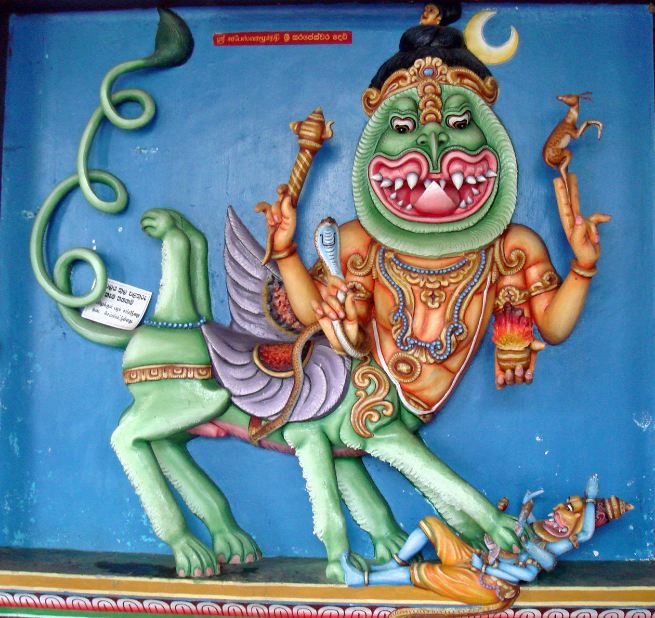
Perhaps one of the least known stories about Shiva is his fight with Narasimha avatara of Lord Vishnu in the form of Sharabha. One version says he killed Narasimha! Another says Vishnu assumed another superhuman form Gandaberunda to fight Sharabha.
The mythical creature Sharabha shown here is part-bird and part-lion. Shiva Purana describes Sharabha as thousand-armed, lion-faced and with matted hair, wings and eight feet. In his clutches is Lord Narasimha, whom Sharabha slays!
First, Vishnu assumed the form of Narasimha to slay Hiranyakashipu, an asura (demon) king, who was terrorizing the universe and devotee of Shiva.The Shiva Purana mentions: After slaying Hiranyakashipu, Narasimha’s wrath was not appeased. The world trembled, fearing what he might do. The Devas (the gods) requested Shiva to tackle Narasimha. Initially, Shiva brings forth Virabhadra, one of his terrifying forms, in order to calm Narasimha. When that failed, Shiva manifested as the human-lion-bird Sharabha.
Shiva then assumed the Sharabha form. Sharabha then attacked Narasimha and seized him up until he was immobilized. He thus quelled Narasimha’s terrifying rage. Narasimha became a devotee of Shiva after being bound by Sharabha. Sharabha then decapitated and de-skinned Narasimha so Shiva could wear the hide and lion-head as a garment. The Linga Purana and Sharabha Upanishad also mention this mutilation and murder of Narasimha. After the mutilation, Vishnu assumed his normal form and retired to his abode, after duly praising Shiva. It was from here on that Shiva came to be known as "Sharabeshamurti" or "Simhagnamurti".
This myth is particularly interesting because it brings to forth the past rivalries between Shaivites and Vaishnavites.
The Vaishnavites have a similar story of Vishnu transforming into Gandaberunda to fight Sharabha, in yet another bird form: a 2 headed eagle.
2. The Story of Lord Shiva – Shiva Lingam:
Lord Shiva is so often represented as a "lingam". Linga basically means a sign or symbol. So the lingam is essentially a symbol of the shapeless universal consciousness of Lord Shiva.
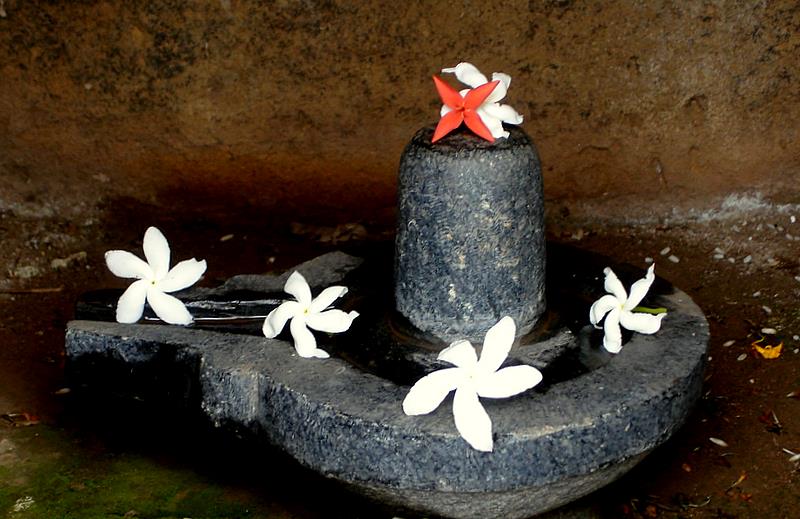
There are a few versions according to the Puranas of why Shiva is worshiped as a lingam and how this happened, of which I will relate one. There was a great sacrificial ceremony that was going to take place many hundreds of years ago. The great sage Narada Muni was invited to it and asked who would receive the effects of the sacrifice. No one could answer, so the sages who were present asked him who should receive it. Narada said that Sri Vishnu, Brahma, and Shiva were all eligible, but they would have to find out which one had the most patience and purity to be the receiver of the sacrifice. So he chose the great sage Brighu to learn the answer.
Brighu had many mystic powers and was able to travel to the domain of the demigods. So first he went to see Lord Brahma, but Brahma was preoccupied and did not notice Brighu’s presence. Feeling insulted, Brighu cursed Brahma, “You are so proud of your power of creation, you did not notice my arrival. For this you shall have no temples on earth.” Thus, there are very few temples of Brahma on earth. Next, Brighu went to see Shiva in Kailash, but Shiva also did not notice Brighu’s arrival. Brighu, again feeling offended, cursed Shiva to be worshiped only as a lingam on earth. This is the reason why Lord Shiva is primarily represented and worshiped as a lingam on this planet.
3. The Story of Shiva Donation:
Parvati once donated Shiva to Brahma's Sons on Narad's advice. Ya, literally donated. This happened when their second child, Ashokasundari, left home (Kailasha) for meditation.
This is the story: When Kartikeya, their first child, was born, he was given to the Kritikas (some women from Kritika place). This was done because Shiva believed that by growing in that place, he would imbibe skills that would help in warfare later. After coming to Kailasha, he immediately went to train to fight Tarakasura, one of the strongest daemons in the Hindu mythology. Shortly after killing him, he was sent to another kingdom for its protection. So Parvati was not given much opportunities to enjoy the company of her son.
Similar things happened with Ashokasundari. She was shortly motivated to go for meditation.
So Parvati was very upset because her family was never together. Menavati, her mother, tells her that in order to take care of this, Shiva himself should spend more time at home. So now the problem was how to make this happen.
Narad to the rescue! He tells Parvati that when Sachi, the wife of Indra, was having similar problem, she donated Indra to Narad. But Narad gave Indra back to her as he couldn't see any advantage of keeping him. Since then Indra used to spend most of the time at home. So both Menavati and Narad convince Parvati to adopt a similar method. Narad tells Parvati that she could donate Shiv to the 4 Brahma sons – Sanaka, Sanatana, Sanandana and Sanatkumara.
The donation actually happened, but contrary to their expectation, the Brahma sons did not give Shiv back (who would, eh?).
Then there was a massive uproar everywhere as Shiva was no longer taking care of the worldly affairs – he was now a "property" of the Brahma sons and had to obey their orders. So Parvati assumes a form of an old lady and tries to show them how the world would get devastated if Shiva was not freed. They were convinced and let go of Shiva.
4. The Story of Halahala poison:
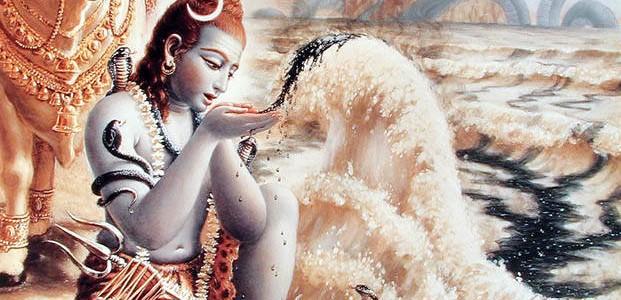
We all know that Shiva is called the "Neelkanth". The story behind the name is certainly one of the most fascinating ones.
The Devas and Asuras got together to churn the Milky ocean to obtain the Amrita. In the process, they obtained a lot of other products as well, which the Devas and Asuras claimed accordingly. Then, it churned out large quantities of the deadly poion Halahala. The Devas and Asuras turned to Brahma, who pointed his hand at Vishnu. Vishnu advised that only Shiva could consume such large quantities of poison.
As per the request of the Devas and Asuras, the calm and composed Shiva drank all the poison that came out of the ocean, without regard for its aftereffects. Parvati was quick to react and pressed Shiva's throat tightly. The caused the poison to stay there, giving a blue color to his throat. Hence the name "Neelkanth".
5. The Story of The Infinite Pillar of Fire:
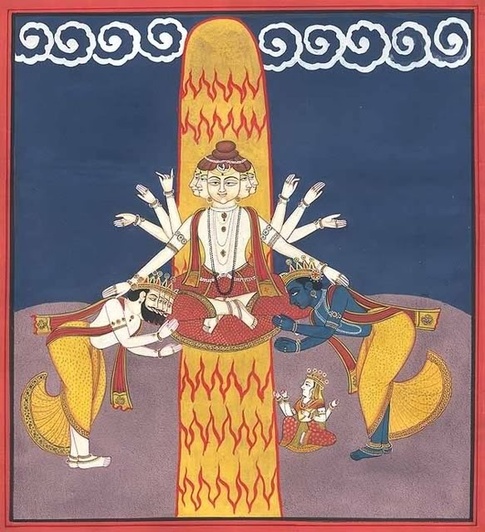
The story goes that there was a conflict between Brahma and Vishnu regarding who was the true God. Then, a long pillar of fire appeared in between them. Determined to find the ends of the pillar, Brahma took the form of a swan and went towards the skies, Vishnu took the form of a boar and dug underground.
Vishnu came back and admitted that the pillar was endless. Brahma however lied about the pillar's limits claiming that he was the true God. Immediately the pillar broke open and Shiva appeared and said to Brahma – "You are a liar. You are not God"; and to Vishnu – "You are humble and accepting the truth. You are in the process of becoming God", hence revealing that Shiva was indeed the true God.
6. The Story of Bhagirath and Ganga:
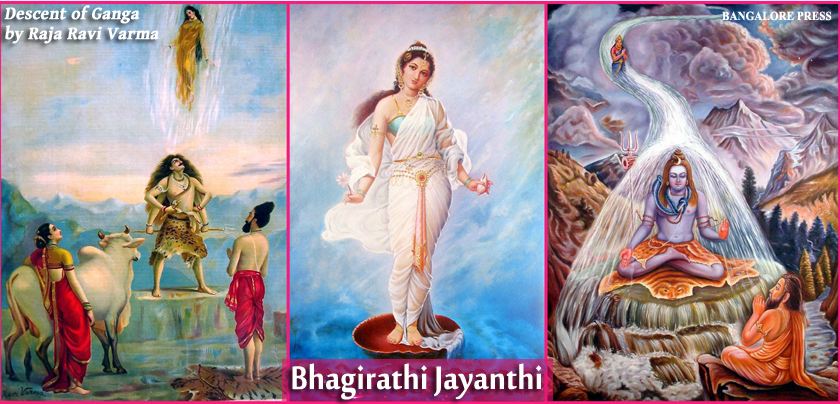
A legend from the Ramayana speaks of King Bhagirath who once meditated before Lord Brahma for a thousand years for the salvation of the souls of his ancestors. Pleased with his devotion Brahma granted him a wish. He requested the Lord to send the river Ganges down to earth from heaven so that she could flow over his ancestors' ashes and wash their curse away and allow them to go to heaven.
Brahma granted his wish but asked him to pray to Shiva, for he alone could support the weight of her descent. Accordingly he prayed to Shiva and he allowed the Ganges to descend on his head, and after meandering through his thick matted locks, the holy river reached the earth. This story is re-enacted by bathing the 'lingam'.
7. The Story of SUDARSHAN CHAKRA:
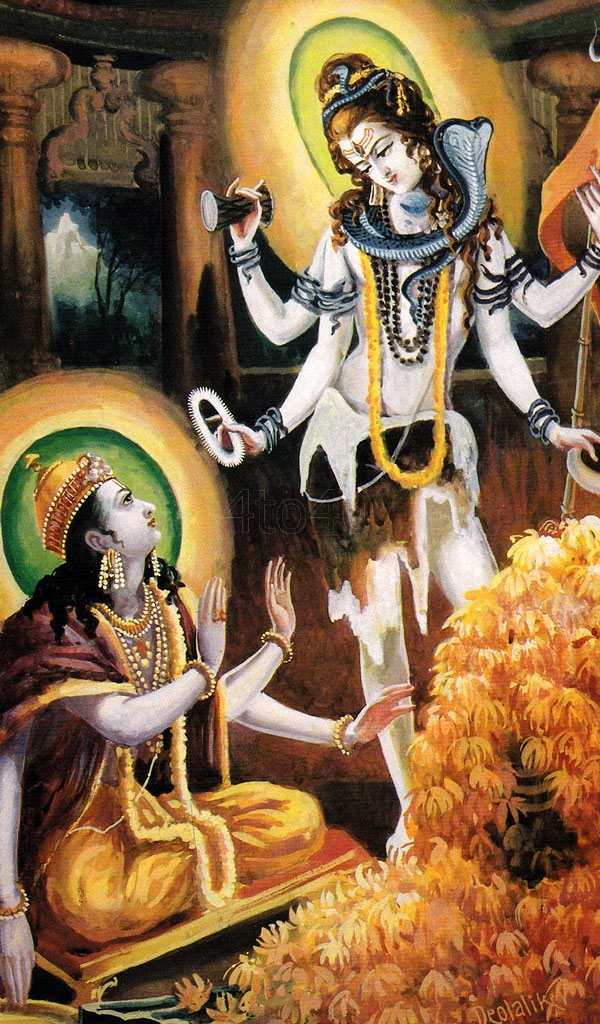
Once Lord Vishnu was worshiping Mahadev. He was reciting Mahadev's 1000 names one after another and with each name he was offering him a flower. Mahadev was impressed with such devotion but wanted to check for his true devotion and so decided to test him. Mahadev with his power's removes one flower from the 1000 flower's that Lord Vishnu had. Lord Vishnu had no clue about this. When Lord Vishnu said the 1000th name,he was surprised to see that he was short of one flower. He decided to do something. He took out one of his eye's and offered it to Mahadev. Mahadev was very impressed with Lord Vishnu's true devotion. Mahadev appeared in front of Lord Vishnu and said to him that he was worthy of something special. Mahadev gave Lord Vishnu what we know as 'THE SUDARSHAN CHAKRA'.
8. The Tiger & the Leaves:
Once a hunter while chasing a deer wandered into a dense forest and found himself on the banks of river Kolidum when he heard the growl of a tiger. To protect himself from the beast he climbed up a tree nearby. The tiger pitched itself on the ground below the tree fostering no intention to leave.
The hunter stayed up in the tree all night and to keep himself from falling asleep, he gently plucked one leaf after another from the tree and threw it down.
Under the tree was a Shiva Linga and the tree blessedly turned out to be a bilva tree. Unknowingly the man had pleased the deity with bilva leaves. At sunrise, the hunter looked down to find the tiger gone, and in its place stood Lord Shiva. He prostrated before the Lord and attained salvation from the cycle of birth and death.
9. Shiva Burning Kamadeva:
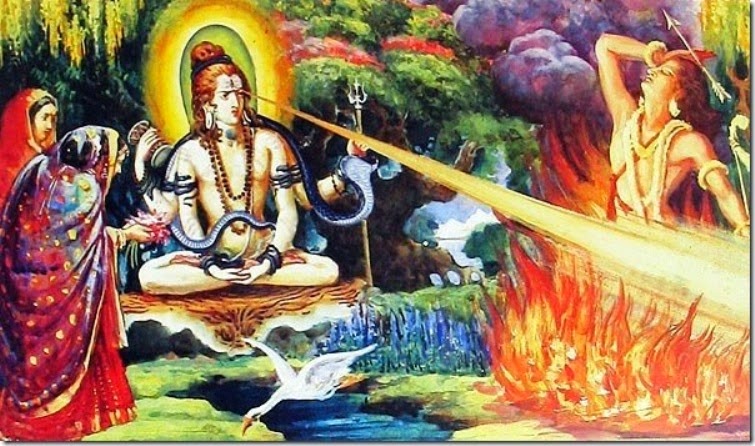
Kamadeva is the Hindu God of Love and in an important story in the Puranas, Kamdeva was assigned with the mission to stop Lord Shiva’s penance that he started after the death of Sati Devi. After the death of Sati, Lord Shiva entered into yogic penance in the Himalayas. Lord Shiva was no longer interested in the world.
Taking advantage of the situation, a demon named Tarakasura, son of Vjranga and Varangi, did Tapas (penance and austerities) and pleased Lord Brahma and got two boons. As the first boon, he asked Brahma to make him the most powerful man in the world. As the second boon he sought that his death should only happen at the hands of a son born to Shiva – thinking that Shiva will never again marry.
After getting the boons, Tarakasura showed his true color and started attacking the demi gods, saints and humans. He defeated all the Kings and Devas and took control over earth and heaven.All the Devas and saints sought refuge at the feet of Brahma who told that the only solution for this problem was to bring back Lord Shiva to the world and stop his penance.
Brahma told them that Goddess Sati was reborn as Goddess Parvati and was doing penance to get Shiva as her husband. But Shiva was not ready to stop his intense penance. Brahma asked the gods to take the help of Kamadeva to stop the penance by creating sexual desire and passion in Lord Shiva. Kamadeva arrived in front of Shiva along with Rati Devi, and shot five arrows of flowers at the heart of Shiva.
Shiva’s meditation was interrupted and he was terribly angry and opened his third eye on his forehead, and a fierce blazing flame came out of his third eye and burned Kamadeva into ashes.The sperm that split from Shiva as the result of the arrows of Kamadeva fell into River Ganga and it was born as six children. These six children were looked after by the Krithiga Stars and were later joined to a single child by Goddess Parvati after her marriage with Lord Shiva. This child was Kartik and he later killed Tarakasura.
Shiva was later convinced regarding the intention of Kamdeva and he was later restored.
10. Story of Ravana shaking Mount Kailash
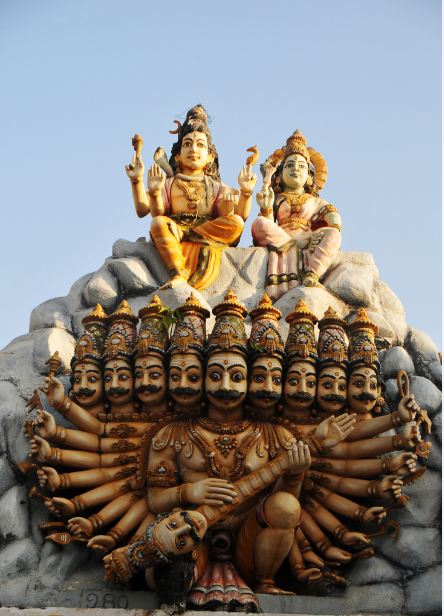
Ravana was one of Shiva's greatest devotees. Once he tried to uproot Mount Kailasa, Shiva's abode in the Himalayas. he could not succeed in this endeavour. Shiva trapped him beneath Kailasa. To redeem himself, Ravana started singing hymns in praise of Shiva. He cut off one of his heads to make a veena and used his tendons as the instrument's string to make music. Eventually, over many years, Shiva did forgive Ravana and freed him from under the mountain. Also, post this episode, Shiva was so moved by Ravana's prayer that he became his favorite devotee. The image below depicts the story.
More Information About Lord Shiva – "Har Har Mahadev"
At the highest level, Shiva is regarded as limitless, transcendent, unchanging and formless. Shiva also has many benevolent and fearsome forms. In benevolent aspects, he is depicted as an omniscient Yogi who lives an ascetic life on Mount Kailash, as well as a householder with wife Parvati and his two children, Ganesha and Kartikeya, and in fierce aspects, he is often depicted slaying demons. Shiva is also regarded as the patron god of yoga and arts.
The main iconographical attributes of Shiva are the third eye on his forehead, the snake Vasuki around his neck, the adorning crescent moon, the holy river Ganga flowing from his matted hair, the trishula as his weapon and the damaru as his musical instrument. Shiva is usually worshiped in the aniconic form of Lingam.
The worship of Shiva is a pan-Hindu tradition, practiced widely across all of India, Nepal and Sri Lanka.
Shiva is the god of the yogis, self-controlled and celibate, while at the same time a lover of his spouse (shakti). Lord Shiva is the destroyer of the world, following Brahma the creator and Vishnu the preserver, after which Brahma again creates the world and so on. Shiva is responsible for change both in the form of death and destruction and in the positive sense of destroying the ego, the false identification with the form. This also includes the shedding of old habits and attachments.
All that has a beginning by necessity must have an end. In destruction, truly nothing is destroyed but the illusion of individuality. Thus the power of destruction associated with Lord Shiva has great purifying power, both on a more personal level when problems make us see reality more clearly, as on a more universal level. Destruction opens the path for a new creation of the universe, a new opportunity for the beauty and drama of universal illusion to unfold. As Satyam, Shivam, Sundaram or Truth, Goodness and Beauty, Shiva represents the most essential goodness.
While of course many hindu deities are associated with different paths of yoga and meditation, in Shiva the art of meditation takes its most absolute form. In meditation, not only mind is stopped, everything is dropped. In deep meditation or samadhi, even the object of the meditation (like a mantra) is transformed into its formless essence, which is the essence of everything and everyone. Thus Shiva stands for letting go of everything in the world of forms. The path of Lord Shiva is the path of the ascetic yogi.
Shiva has many forms, which are visible in his Panchavaktra form with 5 heads, a combination of all Shiva energies : Aghora (resides in the creamation grounds), Ishana (most often appears as the shivalingam), Tat Purusha (meditating), Varna Deva (the eternal Shiva) and Saddyojat or Braddha Rudra (the old wrathful form). The last also forms the connection to the Rudraksha – a rosary made of the dried fruits of the Rudraksha tree.
Another form is the Nataraj. Shiva Nataraj's dance represents both the destruction and the creation of the universe and reveals the cycles of death, birth and rebirth. His Dance of Bliss is for the welfare of the world. In the pose of Nataraj, the King of Dance is giving darshan to his beloved devotees within the "Hall of Consciousness";, which is the heart of man. Under his feet, Shiva crushes the demon of ignorance called Apasmara Purusha, caused by forgetfulness. One hand is stretched across his chest and points towards the uplifted foot, indicating the release from earthly bondage of the devotee. The fire represents the final destruction of creation, but the dance of the Nataraj is also an act of creation, which arouses dormant energies and scatters the ashes of the universe in a pattern that will be the design of the ensuing creation.
Yet another manifestation of Lord Shiva is said to be Hanuman, the ultimate karma yogi, in never-ending selfless service to Ram. The fact that this is not really clear can be perfectly explained by the understanding that a true karma yogi will never take the credit for his acts, as they would otherwise not be entirely selfless. The ego would still get the credit. So, in order to respect Shiva as a true karma yogi, let us not pay too much attention to this manifestation.
The Mahamrityunyaya form of Shiva is the great conqueror of death. The Mahamrityunjaya mantra is one of the two main mantras of the Vedas, next to the Gayatri mantra. It is chanted to remove death and disease. This form of Shiva also is the being of pure joy, referring to the unconditioned enjoyment of the perfectly peaceful mind. That is the true nature of the divine elixir that this Shiva offers his devotees in no less than four hands.
Another main form of Shiva is Ardhnarishwara, half Shiva, half Shakti. Also related to Shiva is Indra
Attributes of Lord Shiva
Shiva's main attributes are
1. The trident that represents the three gunas
2. The snakes that show he is beyond the power of death and poison and also stand for the Kundalini energy.
3. The sound of Shiva's two-sided drum maintains the rhythm of the heartbeat and creates the sound AUM in the overtones.
4. The vehicle of Shiva is the white bull called Nandi (the joyful).
5. Shiva is often seated on a tiger skin or wears a tiger skin, with the tiger representing the mind.
6. Shiva lives on Mount Kailasa in the Himalayas.
H/T: quora.com
[divider scroll_text=”Back To Top”]
